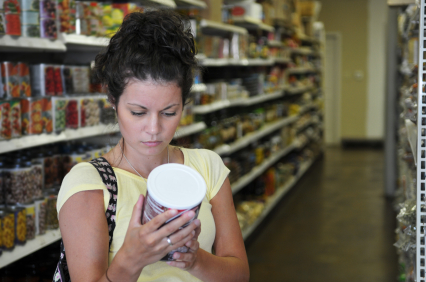Kidney Diet Tips: Finding Nutrients in Food
 Where do you go for help when you want to find out the nutrients in your food? Knowing protein, carbohydrate, fat, sodium, potassium, phosphorus and calcium content of food helps you make better decisions…and may influence how closely you stick to your kidney diet. There are several sources to consider.
Where do you go for help when you want to find out the nutrients in your food? Knowing protein, carbohydrate, fat, sodium, potassium, phosphorus and calcium content of food helps you make better decisions…and may influence how closely you stick to your kidney diet. There are several sources to consider.
Food Labels
The most obvious nutrient source is the food label, available on all packaged foods. Many grocery stores provide nutrient information for fresh produce, and soon fresh meat will require a nutrition label. The drawback is that potassium and phosphorus are optional on food labels and these are among the most important ones you need to know if you have chronic kidney disease or if you are on dialysis.
Food Composition Books
Any bookstore has a variety of food composition books that list nutrients in foods. Your dietitian most likely has a copy of “Bowes and Church’s Food Values of Portions Commonly Used”, a comprehensive nutrition data book with thousands of foods, now in its 18th edition.
Other food composition books vary in the nutrients included. A few on my shelf include “The Complete Book of Food Counts and Vitamin and Mineral Counter”, both by Corrine Netzer, and “The Calorie King Calorie, Carbohydrate and Fat Counter” from dietitian Alan Borushek. If you still prefer a book over an electronic reader or computer, these resource books are a good investment. Some are available to download an electronic version. An extensive list of food composition resources is available from the USDA National Agriculture Library.
On a smaller scale, you can order a pocket guide from the American Association of Kidney Patient. It gives potassium, phosphorus, sodium and protein values for many commonly eaten foods.
Nutrition Databases
As a USA taxpayer, you have invested in a nutrient database that is available to anyone without charge. You can download the USDA nutrient database directly to your computer desktop and easily look up foods. Almost all the foods in this database contain potassium and phosphorus values, and it is updated once a year. One drawback is you won’t find brand name and restaurant foods, but many generic descriptions can be found. I keep the most recent version right on my computer desktop so it is easy to access and use.
Another quick look-up tool is the Food Analyzer on DaVita.com. Keep this tool in your favorites to easily look up thousands of food. This special database has a filter to only include items with potassium and phosphorus, a feature missing from many online food analysis tools.
Looking for more? DaVita Diet Helper is a no-charge online meal planner with already planned menus, a Food Analyzer and Nutrition Log. You can track the foods you eat and instantly see nutrient totals, including calories, protein, carbohydrate, sugars, fat, saturated fat, cholesterol, fiber, sodium, potassium, phosphorus and calcium. Your data is saved and automatically broken down into meals, snacks and daily total. There are other online meal planners, but Diet Helper has two features that are missing from other planners. It is based on protein, potassium, sodium and phosphorus instead of calories to provide customized meals for kidney diets; plus all the foods in the database contain values for all the above nutrients, unlike some programs that do not include potassium and phosphorus for all foods.
Nutrition Software Programs
You can purchase nutrient software programs that have additional features like diet and exercise analysis, scoring systems, weight trackers, menu planners, and recipe features. These programs usually include the USDA database as well as generic, brand name and restaurant foods. There are many simple, easy to use programs, such as Dine Healthy, or a number of other software programs at the Nutrition and Food Web Archive. You can get more bells and whistles from larger programs like The Food Processor or Compu Food Analysis. A Google search will reveal many options and information on nutrition software programs.
There’s an App for That
In addition to the above resources you can find many apps for your smartphone or other devices. These apps make it much easier to track your food intake throughout the day and to have real-time data to help make decisions about what to eat on your kidney diet. Kidney Diet offers an app secifically for people following a kidney diet with a focus on protein, potassium and phosphorus.
Regardless of the source you use to find out the nutrients in your food, learning and sticking to a kidney diet is easier when you have tools and resources to help you choose the best foods for your health.
Kidney diet resources from DaVita.com
- Review and rate recipes
- Discussion Forums
- Monthly Recipe Alerts
- DaVita Diet Helper
- Phosphorus ChallengeTM
- Food Analyzer
- DaVita Cookbooks

Recent Comments